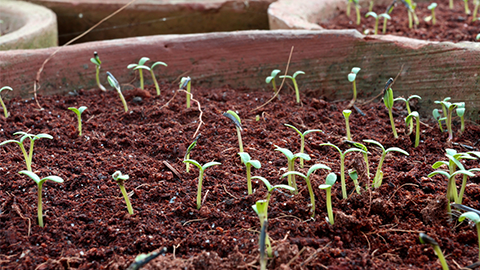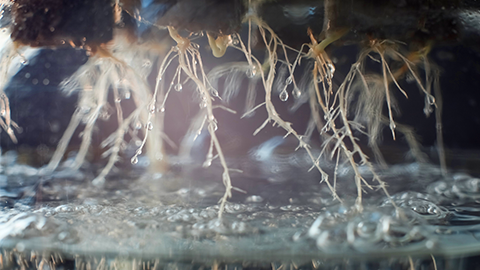Soil is the most common medium used for growing plants in, but there are other options. In this topic we’ll briefly introduce some others that you may come across during your site visits.
Advantages of soil
Soil is the preferred growing medium for plants for several reasons:
- Nutrient availability: Soil contains essential nutrients that plants need for growth, such as nitrogen, phosphorus, and potassium. These nutrients are released slowly over time as organic matter in the soil breaks down, providing a continuous source of nutrition for plants.
- Water retention: Soil can hold water and nutrients, making them available to plants when needed. This is important for plants to survive in dry periods and to avoid waterlogging during heavy rainfall.
- Physical support: Soil provides physical support to plants, anchoring them in place and providing a stable base for root growth. This allows plants to grow taller and stronger than they would in other growing media.
- Microbial activity: Soil contains a wide range of beneficial microbes that help to break down organic matter, release nutrients, and promote plant growth. These microbes create a symbiotic relationship with plants, providing a healthy environment for growth.
- Accessible: In most parts of the world, soil is easy to find and if it needs to be bought it’s relatively inexpensive.
Overall, soil provides a balanced and stable environment for plant growth, making it the preferred growing medium for most plants. However, it is important to note that not all soils are created equal, and certain plants may thrive better in specific soil types or with specific amendments added.
Disadvantages of using soil
Additionally, there are some drawbacks to growing in soil:
- Drainage: Depending on the soil type and composition, it may not drain well, which can lead to waterlogging and root rot.
- Nutrient imbalances: Soil nutrients can vary depending on the location and may require additional fertilization to ensure plants receive the necessary nutrients.
- Soil-borne diseases: Soil can harbor harmful bacteria, fungi, and viruses that can infect plants and reduce yields.
- Dormant weed seeds: Weed seeds can remain dormant in the soil for years, decades or even centuries, but germinate when ideal conditions are present.
- Soil compaction: Soil can become compacted over time, reducing root growth and water and nutrient uptake.
- pH imbalances: Soil pH can vary widely, and plants have specific pH requirements for optimal growth. If the soil pH is not suitable for the plant, it can affect growth and yield.
- Limited space: Soil-based gardening may require a large amount of space, which may not be available in some locations or for indoor gardening.
For these reasons, some growers opt for different growing media or growing systems.
Potting mix is a soilless growing medium that is specifically designed for potted plants. It is typically made up of a combination of materials such as peat moss, vermiculite, perlite, coconut coir, and other organic materials.
Mitre10 Tui's Essentials line, All Purpose Potting Mix.
Advantages of potting mix
Some of the advantages of growing plants in potting mix include:
- Improved drainage: Potting mix is designed to have excellent drainage, which prevents waterlogging and promotes healthy root growth.
- Reduced risk of soil-borne diseases: Soil can harbor harmful bacteria, fungi, and viruses that can infect plants and reduce yields. Potting mix is sterile and free of soil-borne pathogens, which reduces the risk of disease.
- Better aeration: Potting mix is designed to be light and fluffy, which provides good aeration and allows roots to breathe.
- Consistent quality: Potting mix is produced under controlled conditions, ensuring consistent quality and a uniform blend of materials.
- Customisable: Potting mix can be customized to meet the specific needs of different types of plants, with different blends and ratios of materials to optimize growth.
- Convenient: Potting mix is easy to use and requires less preparation than soil. It is also lighter and more manageable than soil, making it easier to move and transport.
Disadvantages of potting mix
While there are many advantages to using potting mix as a growing medium, there are also some potential drawbacks that should be considered, including:
- Limited nutrient content: Most potting mixes do not contain significant amounts of nutrients, and those that do may not have all of the nutrients needed for optimal plant growth. This means that plants grown in potting mix will need regular fertilization to ensure they have access to the necessary nutrients.
- Drying out quickly: Because potting mix is designed to have excellent drainage, it can dry out quickly, especially in hot and dry environments. This can make it challenging to keep plants adequately watered and may require more frequent watering.
- Cost: High-quality potting mix can be more expensive than soil, especially if you need to purchase large quantities.
- Environmental concerns: Some potting mixes contain peat moss, which is harvested from sensitive wetland habitats. This can have negative impacts on the environment, and there are concerns about the sustainability of peat moss harvesting.
- pH levels: Potting mixes can have a higher pH level than soil, which can affect nutrient availability and plant growth.

Cocopeat, also known as coir pith, is a growing medium made from coconut husks. It is a renewable and sustainable alternative to peat moss, which is often used as a soil amendment. If you’ve seen the Countdown Little Garden plants, you’ll know cocopeat; the “soil tablet” that comes with them is made of cocopeat.
Cocopeat is created by grinding up coconut husks and processing them to remove the long fibers, leaving behind a fine, fibrous material. The cocopeat is then washed, dried, and compressed into blocks or bags for use as a growing medium.
Advantages of cocopeat
Cocopeat has several advantages as a growing medium:
- Good water retention: Cocopeat can hold many times its weight in water, which makes it an excellent growing medium for plants that require consistent moisture.
- Excellent aeration: Cocopeat is lightweight and airy, which provides good aeration and allows roots to breathe.
- High porosity: Cocopeat has a high porosity, which helps to prevent soil compaction and promotes healthy root growth.
- Good drainage: Cocopeat has excellent drainage properties, which helps to prevent waterlogging and root rot.
- Sustainable: Cocopeat is a renewable and sustainable resource, as it is made from a waste product of the coconut industry.
- Low pH: Cocopeat has a low pH level, which makes it ideal for growing acid-loving plants such as blueberries, rhododendrons, and azaleas.
- Resistant to pests and diseases: Cocopeat is resistant to pests and diseases, which reduces the risk of plant damage and the need for chemical treatments.
It should be noted that peat moss is a similar type of growing medium, but one that is unsustainable. Peat moss is made by harvesting peat bogs, which are important ecosystems. As a result, cocopeat has become a more popular, and sustainable alternative.
Disadvantages of cocopeat
While there are many advantages to using cocopeat as a growing medium, there are also some potential disadvantages that should be considered, including:
- High salt content: Cocopeat can have a high salt content, which can be harmful to some plants, especially those that are sensitive to salt.
- Lack of nutrients: Cocopeat has a low nutrient content and is often used in conjunction with fertilizers to provide the necessary nutrients for plant growth.
- High acidity: While the low pH of cocopeat can be an advantage for acid-loving plants, it can be a disadvantage for plants that prefer a neutral or alkaline soil.
- May require special handling: Cocopeat can be dusty and messy to work with and may require special handling and equipment to mix and apply.
- Susceptible to mold and fungus: Cocopeat can be susceptible to mold and fungus growth, especially if it becomes overly wet and doesn't have good air circulation.
- Difficulty in re-wetting: If cocopeat dries out completely, it can be difficult to re-wet and can form a hydrophobic layer, preventing water from penetrating the surface.

This is a close-up image of a deep water culture hydroponic system.
Hydroponics is a method of growing plants without soil, in which plants are grown in a nutrient-rich water solution. The roots of the plants are directly exposed to the nutrient solution, which is usually oxygenated to ensure the plants receive sufficient oxygen.
Hydroponic systems can range from simple setups such as a container with a nutrient solution and plants suspended in it, to more complex systems such as nutrient film technique (NFT) or deep-water culture (DWC) systems.
Hydroponics has several advantages over traditional soil-based agriculture, including faster growth rates, higher yields, and the ability to grow crops in areas where soil is not available or contaminated. It also allows for precise control over nutrient levels and pH, which can result in healthier and more productive plants.
Even though it focuses on energy efficiency, the following video by Energy Answers for the Beginning Farmer & Rancher (🕜 7:13) provides a good introduction to commercial hydroponic systems:
Advantages of hydroponic systems
Key advantages of hydroponics systems include:
- Water conservation: Hydroponic systems use up to 90% less water than traditional soil-based growing systems because the water is recirculated and reused.
- Faster growth: Plants in hydroponic systems grow up to 50% faster than those in soil-based systems because they have direct access to all the necessary nutrients and water.
- No soil-borne diseases: Since hydroponic systems don't use soil, there is less risk of soil-borne diseases that can affect plants.
- Greater control over plant growth: Hydroponic systems allow for precise control over the growing environment, including temperature, humidity, and nutrient levels. This means that growers can optimize the growth conditions for specific plant species, resulting in healthier and more productive plants.
- Higher yields: Hydroponic systems can produce higher yields per square foot of growing space compared to soil-based systems because of the faster growth and greater control over the growing environment.
- Efficient use of space: Hydroponic systems can be set up in smaller spaces and can be vertically stacked, making them ideal for urban environments where space is limited.
- Sustainable agriculture: Hydroponic systems can be designed to be completely sustainable by using renewable energy sources, minimizing waste, and recycling nutrients.
Disadvantages of hydroponic systems
While there are many advantages to using hydroponics, there are also some potential drawbacks that should be considered, including:
- High initial costs: Hydroponic systems can be more expensive to set up compared to traditional soil-based growing systems, as they require specialized equipment and materials.
- Technical knowledge required: Hydroponic systems require a certain level of technical knowledge and expertise to set up and maintain, including understanding the nutrient requirements of plants and managing the pH and electrical conductivity of the nutrient solution.
- Power outages can be detrimental: Hydroponic systems rely on electricity to pump water and nutrients to the plants. If there is a power outage, the plants can quickly suffer without water and nutrients.
- Disease and pest management: While hydroponic systems are less prone to soil-borne diseases, they are still susceptible to other types of plant diseases and pests that can be more challenging to manage in a hydroponic environment.
- Maintenance requirements: Hydroponic systems require regular maintenance, including monitoring and adjusting nutrient levels, cleaning and sterilizing equipment, and ensuring proper ventilation.
- Dependence on nutrient solution: Hydroponic systems rely entirely on nutrient solutions to provide plants with the nutrients they need. If the nutrient solution is not properly balanced or managed, it can lead to nutrient deficiencies or toxicities that can harm plant growth.
